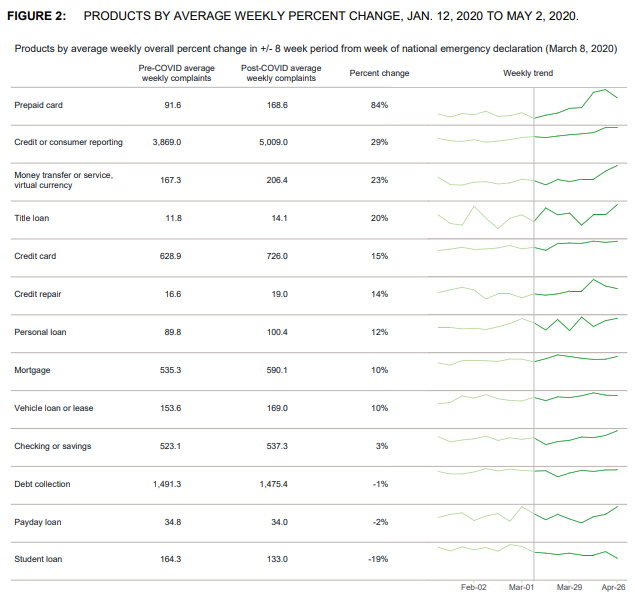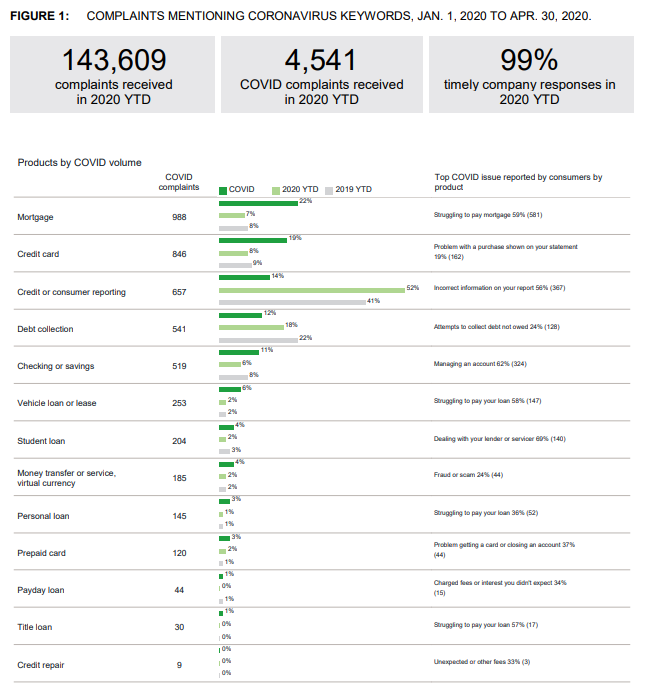On May 21, the Consumer Financial Protection Bureau (CFPB) released a special COVID-19 edition of its Complaint Bulletin. The CFPB observed trends in its complaint database, particularly to determine what impact the pandemic is having on consumer complaints. The most interesting observation for the industry (even though it is not called out by the CFPB): debt collection continues to drop down from its prior spot as the most complained-about product.
Debt Collection Complaints: The Trend
While the CFPB calls out credit reporting and debt collection as the two most complained-about consumer financial products, the rest of the report shows that debt collection complaints falling further and further behind credit reporting in this category.
Specifically, in a chart that compares the average weekly complaints pre- and post-COVID by product, debt collection is one of three products—out of thirteen total—that had a negative percentage change.

One other area that evidences that debt collection compalints are no longer top-dog: the chart where the CFPB tracked coronavirus keywords in complaint by products (see section below). In addition to tracking keywords, the chart also includes a product-by-product comparison of year-to-date percentage of total complaints for 2019 and 2020 (as of April 30 of both years). Debt collection complaints accounted for 22% of total complaints YTD in 2019, whereas in 2020 that percentage dropped to 18%.
Later in the Bulletin, the CFPB mentions that, "[c]onsumers described continued attempts by companies to collect a debt. Consumers who received collection attempts by companies expressed dismay that companies are continuing collection activities during a national emergency."
Credit Reporting Complaints Continue Upward Trend
While debt collection complaint oercentages are seeing a small downward trend, credit reporting complaints are continuing to see fairly steady increase in volume, especialy post-COVID where the newly-enacted CARES Act has some implications. The CFPB states, "[s]ome consumers who are pursuing alternative payment options expressed concern about the potential negative credit reporting implications. Some consumers are concerned about negative reporting and, consequently, a reduced ability to obtain financing."
COVID-19 Keywords
One of the highlights of this edition of the Bulletin is that it tracked the number of complaints received for each product that referenced keywords related to the pandemic. Debt collection is fourth on the list, with only 12% of debt collection complaints contained a triggering keyword. The frontrunner products with COVID-19 keywords are mortgage (22%), credit card (19%), and credit reporting (14%).

Consumers Unable to Contact Companies
One other note to highlight about this report is that consumers are complaining that they are unable to reach customer service representatives to discuss issues. The report notes, "[s]ome consumers are reporting hold times of several hours. For those who are pursuing payment options, some described no method other than phone to access potential options."
This is an issue described for mortgage, credit card, vehicle loan/lease, student loan, and personal loan products.
[article_ad]
insideARM Perspective
Let's focus for a moment on that last point and discuss the need for self-service portals for consumers. While debt collection is not one of the products listed with the issue of access to customer service, it never hurts to see how companies can improve their functionality.
A customer self-service portal would help alleviate the issue of long wait times. Many debt collectors already have online payment portals, some even utilize artificial intelligence to negotiate repayment plans with consumers—all without the consumer ever having to speak to a person. The debt collection industry has been hit just like every other industry during this pandemic, with some debt collectors having to lay off employees or otherwise downsize their businesses. This type of technology helps alleviate the question of how to continue servicing customers when the number of phone representatives decreases.




![Photo of Katie Neill [Image by creator from ]](/media/images/Katie_Neill.2e16d0ba.fill-500x500.jpg)
![the word regulation in a stylized dictionary [Image by creator from ]](/media/images/Credit_Report_Disputes.max-80x80.png)
![[Image by creator from ]](/media/images/Credit_Report_Disputes.max-80x80.jpg)


![[Image by creator from ]](/media/images/New_site_WPWebinar_covers_800_x_800_px.max-80x80.png)
![[Image by creator from ]](/media/images/Finvi_Tech_Trends_Whitepaper.max-80x80.png)
![[Image by creator from ]](/media/images/Collections_Staffing_Full_Cover_Thumbnail.max-80x80.jpg)
![Report cover reads One Conversation Multiple Channels AI-powered Multichannel Outreach from Skit.ai [Image by creator from ]](/media/images/Skit.ai_Landing_Page__Whitepaper_.max-80x80.png)
![Report cover reads Bad Debt Rising New ebook Finvi [Image by creator from ]](/media/images/Finvi_Bad_Debt_Rising_WP.max-80x80.png)
![Report cover reads Seizing the Opportunity in Uncertain Times: The Third-Party Collections Industry in 2023 by TransUnion, prepared by datos insights [Image by creator from ]](/media/images/TU_Survey_Report_12-23_Cover.max-80x80.png)
![Webinar graphic reads RA Compliance Corner - Managing the Mental Strain of Compliance 12-4-24 2pm ET [Image by creator from ]](/media/images/12.4.24_RA_Webinar_Landing_Page.max-80x80.png)